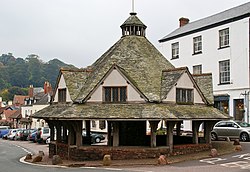Yarn Market, Dunster
| Yarn Market | |
|---|---|

The Yarn Market, Dunster
|
|
| Location | Dunster, Somerset, England |
| Coordinates | 51°11′04″N 3°26′39″W / 51.18444°N 3.44417°WCoordinates: 51°11′04″N 3°26′39″W / 51.18444°N 3.44417°W |
| Built | c. 1600 |
| Rebuilt | 1647 |
| Governing body | National Trust |
|
Listed Building – Grade I
|
|
| Official name: Yarn Market | |
| Designated | 22 May 1969 |
| Reference no. | 264694 |
| Reference no. | Somerset County No 32 |
The Yarn Market in Dunster, Somerset, England was built in the early 17th century. It has been designated as a Grade I listed building and scheduled monument. Dunster was an important market place in the Middle Ages particularly following the construction of Dunster Castle and the establishment of the Priory Church of St George.
The market cross was probably built in 1609 by the Luttrell family who were the local lords of the manor to maintain the importance of the village as a market, particularly for wool and cloth. It still bears the damage caused by cannon fire in the Civil War. Nearby was an older cross known as the Butter Cross which has subsequently been moved to the outskirts of the village. The Yarn Market is an octagonal building constructed around a central pier. The tiled roof provides shelter from the rain.
Dunster Castle stands on a site which has been fortified since the late Anglo-Saxon period, signifying the importance of the area. After the Norman conquest of England in the 11th century, William de Mohun constructed a timber castle on the site as part of the pacification of Somerset.
A stone shell keep was built on the motte by the start of the 12th century, and the castle survived a siege during the early years of the Anarchy. At the end of the 14th century the de Mohuns sold the castle to the Luttrell family.
...
Wikipedia

